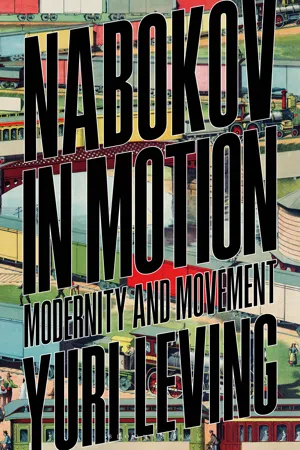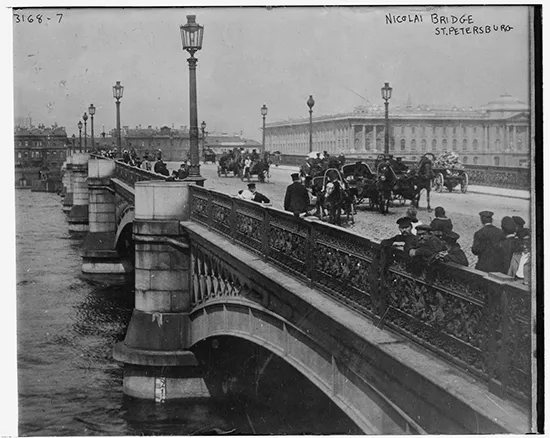![]()
1
Chaos and Order
On the Poetics of Urbanism
I am writing these lines by electricity,
And at the gate sits an automobile, humming;
Starry flags flew up at the terminals;
The “Titanic” class rocks the ocean;
Submarines cut open its depths,
And into the blue flew an airplane rattling.
—Valery Briusov, Under Electricity
The complex process of urbanization left its mark on our cultural codes, warped the fabric of our language, created new motifs, and gave the literary world a great many unexpected conflicts for plot material.
This book examines and interprets the personal mythology of Vladimir Vladimirovich Nabokov in a broad context of prose and poetry limited by time (1837–1977) and thematic constraints, in a synchronic cross-section, and from the point of view of what we will call the poetics of urbanism in literature. In contemporary literary studies, “urbanism” is generally understood to mean the interaction of technological innovations and the “corporeal world” with human culture, and the subsequent mapping of this process onto an artistic text.
When presenting a description aimed at the “urbanistic code” as a whole (an attempt to track the motif by modeling a “single” railroad or aviation topos in Russian literature), one cannot avoid smoothing over the idiosyncrasies of specific authors and works to a significant degree. The paradox is that the genius of the artist relies on the transformation of this “predetermined” paradigm. Consequently, as Hanzen-Leve has observed, the more an artist conforms to a general artistic system, the less “effective” he becomes and the more relevant his work is for uncovering the model structure and the typical features of his epoch or period. Hence the large number of marginal prose writers and poets quoted in this book; no effort was made to restrict the field of authors analyzed to those that were within Nabokov’s sphere of awareness or that he engaged with in open or concealed polemics.1 In the decision to include in the textual analysis various documentary sources (newspaper items, correspondence, archival materials, etc.), we are making an a priori assumption that a text is the product of cultural conventions, and constitutes a palimpsest of the collective memory and mythology (Gasparov, Literaturnye leitmotivy, 279–282).
Nabokov is the ideal subject for structuralist analysis. The world of his fiction is riddled with the qualities that Roland Barthes was fascinated by in the work of Jules Verne (Barthes, Mythologies, 401–412), whom Nabokov named as one of his favorite authors when he was a child: both Nabokov and Verne were able to create a self-enclosed “cosmogony,” with its own space and time, replete with recurring motifs and with its own operating principles. The specific nature of Nabokov’s texts and subtexts, and his orientation toward a thoughtful, “interactive” reader and interlocutor are characterized by certain didactic features of the texts. Nabokov’s works, as has been noted a number of times, are tutorial in nature. In figuring out the laws inherent to a particular text, the reader is able on his own to gather the keys that unlock the solution to the “mysteries” presented by a work at all of its different levels.
It is worth saying a few words about the poetics of movement in Russian literature as a whole by way of introduction. A brief but precise overview of the topic was presented in the wide-ranging work by Jerzy Faryno, who noted that, in real life, vehicles and machines are categorized based on prestige and on function (ceremonial/ritualistic or commercial/economic): in other words, by their purpose—transporting passengers or freight, a corpse to a cemetery or a bride and groom to their wedding (Faryno, Vvedenie, 357). Similar meanings, Faryno suggests, must be activated and realized in art as well: in literature, painting, and cinematography. Because the differentiation and symbolism of vehicles are developed in art at a deeper level than in everyday life, artistic space will catalyze and strengthen the mythologizing potential of the mechanisms introduced into the text.2 In Mandel’shtam’s “Concert at the Railway Station” and Pasternak’s Safe Conduct, the locomotive is associated with the archetype of the psychopomp, who leads souls to the next world. The same function is performed by the steamship in Bunin’s “The Gentleman from San Francisco” and by the bus in the eponymous narrative poem by Tsvetaeva. In Slavic cultures, and Russian culture in particular, the locomotive or tram took on, Faryno states, the older symbolism of the horse of folk tales that carried souls across. The horse for avant-garde artists was not merely a domesticated animal, but rather an ancient psychopomp, the “verse-producing Pegasus,” and even a redeemer and savior (in Maiakovskii’s “On Being Kind to Horses”; ibid., 358). The airplane had a similar fate, and additionally acquired the functions of the dragonfly, the mosquito, the soaring and ascending “heavenly spirit”: a new Icarus or Hermes. Modernism’s system of vehicles also mythologized not only bicycles, motorcycles, automobiles, and the metro, but also, less obviously, ice skates (Tsvetaeva’s “Ice skaters,” Nabokov’s “The ice skater,” and poems by Otsup, Sadovskoi, and Mandel’stam, as well as Lyovin’s famous skating scene in Anna Karenina), and skis (Akhmatova’s poem “I know, I know – the skis again,” Nabokov’s “Ski jump,” and Doctor Zhivago). With their special brand of movement and sliding, these also belong to a paradigm such that they occupy the position of “winged” footwear and perform the function of Hermes’ sandals. The position that Nabokov formed early on regarding the evolution and origin of the poetics of movement in human culture3 is most clearly expressed in the final chapter of his autobiography. Instead of “corrupting” Freudian experiments, the author advises that psychologists attempt to explain “the phylogenetic aspects of the passion male children have for things on wheels”:
Of course we know what the Viennese Quack thought of the matter. < … > Rapid growth, quantum-quick thought, the roller coaster of the circulatory system – all forms of vitality are forms of velocity, and no wonder a growing child desires to out-Nature Nature by filling a minimum stretch of time with a maximum of spatial enjoyment. Innermost in man is the spiritual pleasure derivable from the possibilities of outtugging and outrunning gravity, of overcoming or re-enacting the earth’s pull.
(Speak, Memory, 300–301)4
A mechanical means of movement in a literary text is a tool for transporting not only the characters, but also the whole of the literary baggage, seen or unseen, that is affixed by tradition or by the author himself to a particular image. In the chapters to come, we will focus on three modes of transportation that represent the urban idea in literature, and outline the general semantic and symbolic context in which they operate in an artistic system. To leave the topic open for other scholars, we must emphasize that all means of locomotion are important for understanding the structure of a text and its contextual ties, including those to which this book will not devote special attention, such as the bus, bicycle, ship, etc.5
As often happens with Nabokov, a stock image ends up metamorphosing and becomes covered over in metaliterary connotations.
Using the example of the tram, I will show how a universal poetics works in a particular case. The first tram in Petersburg left the Admiralty building on September 16, 1907. Within a year, there were already nine routes operating in the capital city, and by 1913 there were hundreds of cars in the tram fleet. The tram lines were laid beginning in 1905 by the American Westinghouse company, which won the bidding competition for the project. (A scandal surrounding the tram lines in the capital city almost made a widow of Nabokov’s mother, and the writer himself sustained significant psychological trauma.6) The tram, whose appearance on the city streets was immediately reflected in the city’s mythopoetic space (Timenchik, “K simvolike tramvaia”), is among the text-producing symbols capable of reproducing themselves, forming a semantic well where crossover meanings are condensed and associations with other texts arise. Alexander Dolinin has found at least two possible references in The Gift from Soviet poetry of the 1920s in the description of Fyodor working his way to the platform of the tram car: “Just then the wind searched him cruelly after which Fyodor drew the belt of his mackintosh tighter and adjusted his scarf, but the small amount of tram warmth had already been taken away from him” (The Gift, 84). One phrase echoes Maiakovskii’s About This (1923), “The boy was searched by the thief wind,” and another recalls Mandel’shtam’s “You, with the square windows and short houses” (1924): “The absurd final tram warmth!” (see the comment in Russian Collected Works, 4:662). It may be demonstrated that Mandel’shtam’s poetics suffuse the novel further, to the sentence that follows shortly after the previous one: “The tram came out on the square and, braking excruciatingly, stopped, but it was only a preliminary stop, because in front, by the stone island crowded with people standing by to board, two other trams had got stuck, both with cars coupled on, and this inert agglomeration was also evidence somehow of the disastrous imperfection of the world” (The Gift, 84). The tram grinding to a halt seems to refer back to Mandel’shtam’s children’s book, Two Trams (1924–25), about two trams named “Tram” and “Klik” that are separated and suffering (“And Tram finds Klik on the platform”). The fact that this refers to a Petersburg event is reinforced by the phrase “stone island”—a strange designation for a tram stop in Berlin, until we realize that this is in fact a mention of a Petersburg site, “Kamennyi ostrov” (“Stone Island”).7
The theme of Petersburg childhood saturates the opening of the second chapter in The Gift, as Fyodor hurries to class, but memories of Russia confuse his accustomed path through Berlin—until something finally returns him or, more accurately, pushes him back into the flow of the novel’s events. The bit of realia that breaks through the nostalgia for “the hothouse paradise of the past” is in this case an everyday tram (“a dim yellow blotch approaching, which suddenly came into focus, shuddered, thickened and turned into a tramcar”; The Gift, 79). The tram “transports” Godunov-Cherdyntsev from the world of the sharply defined images living in his powerful memory into the excruciating pallid reality to which he is traveling to teach French lessons. Additionally, along the way there is a vexing misunderstanding: the failure to recognize a compatriot whom Fyodor secretly blames for all the ills among banal burghers, until this “German” opens up a Russian newspaper. For our purposes, it is important not so much that the mistake is narrated by Nabokov while contemplating the idea of “how essentially good life is” (ibid., 80), but that here we can trace a literary leitmotif in the “tram plot”—misrecognition in an émigré setting was a common punch line in humorous émigré literature from the middle of the 1920s.8
FIGURE 1.1 The Blagoveshchensky (Annunciation) Bridge which was called the Nikolaevsky Bridge from 1855 to 1918 in honor of Tsar Nicholas I. It was the first permanent bridge built across the Neva River in St. Petersburg, Russia. Glass negative, between c. 1900 and 1907. George Grantham Bain Collection, Library of Congress.
The tram, after gathering up a great number of associated motifs and images in the 1910s, begins in the 1920s (and not only in Nabokov) to p...

